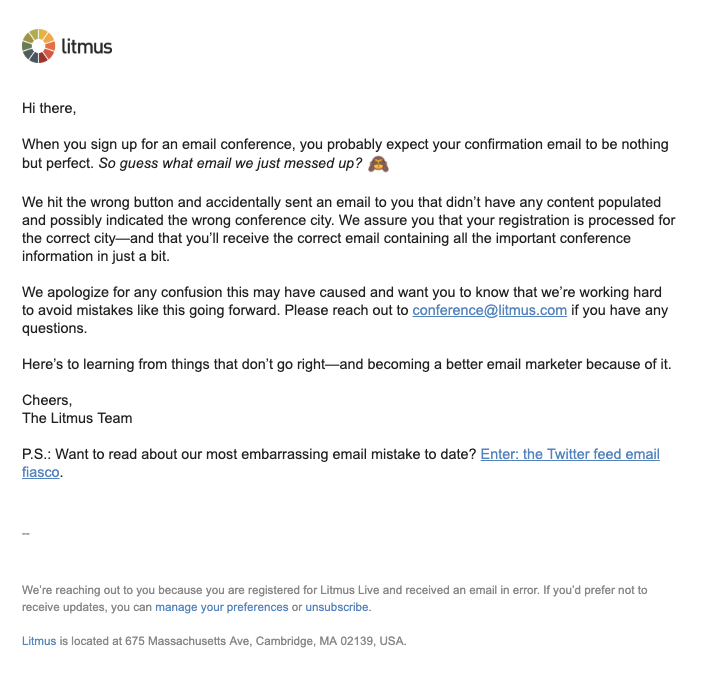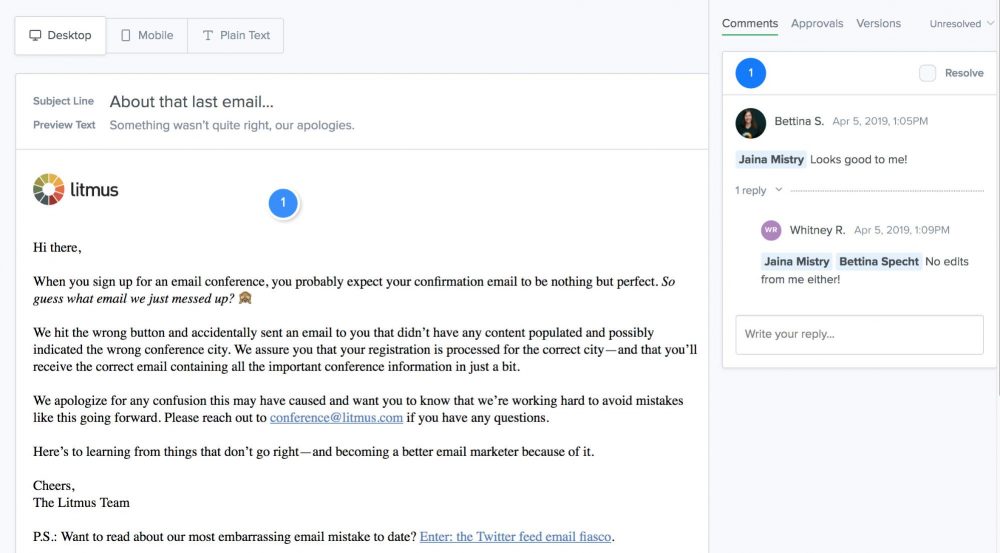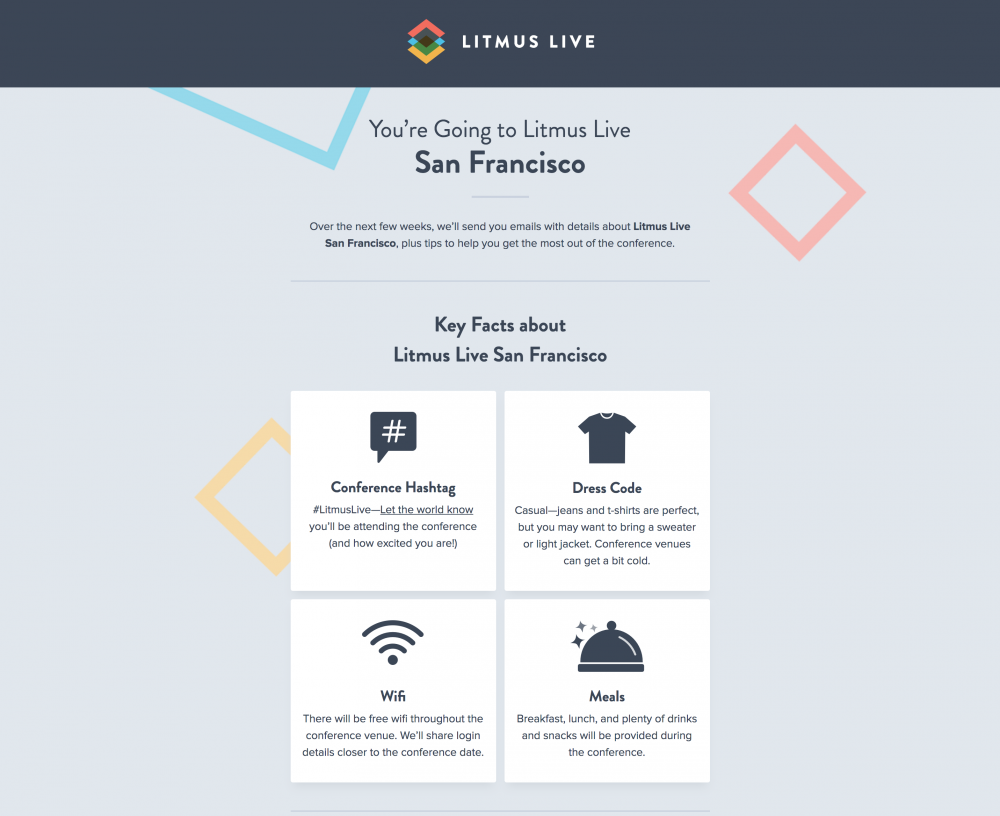How to Keep Calm in an Email Crisis: The Litmus Live Attendee Email Mistake
When you sign up for an email conference, you probably expect your confirmation email to be nothing but perfect. So guess what email we messed up?
As we’ve written about before when our live Twitter feed email imploded, email mistakes are not a matter of “if” but “when.” And Friday of last week was that “when” for us—we sent 150 people who had registered for Litmus Live this content shell instead of their actual attendee welcome email:

One of the most frustrating things about email is that when you make a mistake, there’s rarely a way to fix it post-send. That ugly, weird placeholder email is now in our subscribers’ inboxes—and there’s no way of taking it back. All you can do is figure out a way to minimize the impact of the mistake.
So here’s what we did.
Step 1: Assess the size and impact of the error.
In a crisis, it’s good to try and keep perspective. When we first noticed the mistake, here’s what ran through my head:
- The 150 people who received this broken email were the true #emailgeeks: our devoted email fans who simply had to register for Litmus Live—an event that’s all about becoming a better email marketer.
- They just registered for a conference run by a company whose brand and product is about making great emails. And they just got a really not great email.
Urgh…
In sum, this email error was likely to cause confusion among attendees who were eager to learn more about event details. For some, the email had mentioned the wrong conference city, leaving them wondering whether or not their ticket purchase was processed for the correct city. Plus, as an email company promoting an email conference, sending a broken email isn’t building brand trust, to say the least.
Within just a couple minutes, we received a couple of emails with questions about the broken content (and one really kind Tweet).
@litmusapp that’s the start of the story arc, that leads to a talk on making mistakes in email, right?
— Elliot Ross (@IAmElliot) April 5, 2019
We wish it was, Elliot!
Step 2: Determine the format for the response.
Given the significance of the error and the audience that received the email, it was clear we had to take action. In cases of past mistakes, we had simply re-sent an email with a corrected subject line—but since this was a case where the content wasn’t right, this wasn’t an option.
We determined it would be best to send an email out to acknowledge our mistake and let them know they’d be receiving a corrected email. We had an “oops” email template already ready to go, and this saved us valuable time—all we had to do was tweak the message to help clear up any confusion caused by this specific error, while remaining honest and apologetic.
Pro tip:
Always have an apology email drafted and a template ready to go for whenever you need it. Customizing an existing email is easier (and faster) than starting from scratch during an email crisis.
Here’s what our apology email looked like:

Step 3: Make other people in the company aware of the plan of action.
In a team effort, the above plan was worked out and copy finalized within 15 minutes after the mistake was identified.
Once we determined the course of action, we updated the rest of the team—first and foremost our customer support team—so that they could answer any incoming questions immediately.
Step 4: Get the email response out—and make sure it’s right.
Sending a 100% correct and error-free email response is vital for an apology email—you don’t want to have to send an apology email for your apology email!
With five team members involved, we used Litmus Proof to ensure that what we would be sending is 100% accurate. In Proof, the team double- and triple-checked for spelling and grammar mistakes that may have happened during the rushed copywriting or when copying and pasting from the email copy document.

While time is of the essence when sending an apology email, we didn’t skip or condense our typical QA process. As part of the final QA stage, we ran the email through Litmus Spam Filter Testing to ensure we wouldn’t have any issue on delivery. Plus, we ran the email through Checklist as a final QA to ensure that the subject line, preview text, links, and more are correct before hitting send.
We couldn’t leave these email recipients without the actual email they were meant to receive. The correct email was sent so that the registered attendees had all the information they should have initially received.
For the record, here’s the actual Litmus Live attendee welcome email.

At this point, all impacted subscribers had received both the apology email and the correct email, ensuring they had all the information they need. Now it was time to take a deep breath and move on to the final step in the email crisis recovery process: reflection.
Step 5: Do a postmortem
Post mortem in Latin literally means, “after death.” And after an email crisis, I know I typically am so exhausted I feel dead. But conducting a postmortem is really crucial, and it’s important to do when the events that transpired are fresh on everyone’s minds.
We conduct our postmortems through a shared document, discuss as an email team, and typically complete our recap within 24 hours of the event. In fact, the only reason we had an apology email template ready to go was because of a past mishap, so good things really can come out of bad mistakes.
Here’s what we include in our postmortem document:
- What happened? Including who identified and what time.
- What caused it? Specific details on the system, process, or human error that caused the mistake.
- Who was impacted? Details about how many recipients were impacted and who they are.
- What actions did we take? Did we send an apology email, revise subject line and resend, etc.
- Did we receive any customer feedback? Did we get responses, if so, how many and in what channel.
- Are there any potential longer tail impacts that we must be aware of? Deliverability, introducing people to a series where they may be part of an automation, etc.
- What can we do to avoid mistakes like this one going forward? Any changes in process or technology that can help avoid future mistakes.
The last item on the list is probably the most crucial. Mistakes happen—but you never want to make the same one twice.
Pro tip:
After every email crisis, ask yourself: What can you do to avoid making a similar mistake in the future?
This wasn’t our first email oopsie
We wish we could say this was our first embarrassing email mistake. Truth is, it’s not. Here are two more mishaps that make for funny stories after the fact, but had us panic when they happened:
- See how our live Twitter feed email imploded
- Read how we lost our much-loved #TEDC16 hashtag to US presidential candidate Ted Cruz—and how that really messed with our conference emails.
So if you’ve recently made an email mistake, know that you’re not alone. We’ve made mistakes, and others have too. In our #nofailmail community contest, dozens of fellow email marketers have shared their biggest email marketing mishaps so that we all can learn from them.
Here’s to making mistakes, learning from them, and becoming a better email marketer on the way—even if it’s a painful process.

Heather Moran
Heather Moran was the Director of Email Marketing at Litmus
